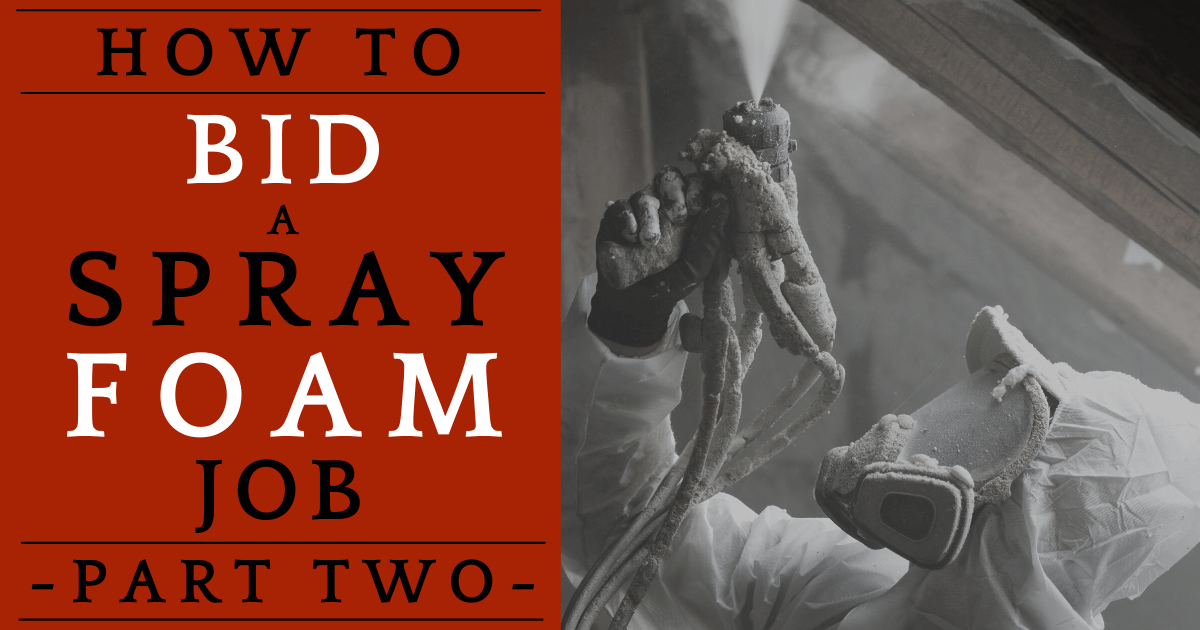How to Bid a Spray Foam Job, Part Two: Estimating Labor Costs and Bidding Odd Jobs Using Machine Stroke Count
In Part One of this post on bidding a spray foam job, we discussed measuring job sites and calculating material costs (check out the post here if you missed it!).
But what about those jobs that are difficult (or impossible) to measure before you spray?
What if the job you’re bidding is a concrete lifting project and you’re not sure exactly how much material you will be using?
How do you charge for those jobs?
And how do you ensure you and your assistants get paid a living wage for every spray foam job?
In this post, we will discuss bidding odd spray foam jobs using machine stroke count and adding labor costs into your job bids.
Let’s go!
Bidding Odd Jobs Using Spray Foam Machine Stroke Count
Most spray foam machines are equipped with a stroke counter. If used correctly, that stroke counter can help you measure the amount of material your machine uses per stroke and, ultimately, estimate your cost per stroke!
Your spray foam machine’s manufacturer calibrates each of their machines to spray a certain amount of foam per stroke, and that information is a great space to start when testing your specific machine.
However, much like you would check the gas mileage in your car, we highly recommend checking your spray foam machine for stroke count per set periodically. Doing so will allow you to better understand your material costs when bidding on spray foam jobs in the future.
To determine your spray foam machine’s stroke count per set of foam, reset your machine stroke counter before spraying a new set of foam, spray the entire set, and check the stroke count after at the barrels are empty.
The number of strokes counted is your machine’s stroke count per set of spray foam. Knowing that number allows you accurately determine how much money you spend on spray foam material per stroke of your machine.
(To find the physical amount of foam sprayed per stroke by your foam machine, simply divide the total volume of your spray foam barrels by the number of strokes it took your machine to spray through them.)
Just like a car’s gas mileage differs depending on road and weather conditions, your spray foam machine’s stroke count per set can vary depending on temperature, spray foam brand, etc. – but you will know enough after performing this test to estimate material costs for future job bids.
To find accurate material costs per stroke of your machine, divide the price of a set of foam by your machine’s (average) stroke count per set.
That simple calculation will give you the material cost for each stroke of your machine.
And your material costs per stroke is the base number you need to charge per stroke for an odd job that is difficult to measure!
To charge your customers using stroke count, reset your stroke counter before starting the job, and let it run until the job is complete. Then, multiply your costs per stroke by the number of strokes your machine counted for the job, and you’ll have the total cost of the project.
If you plan to use this method for bidding jobs, make sure to require at least half of the total estimated cost upfront (yes, you still want to have an estimate for the job), and to settle any remaining balance with your customer before leaving the completed job site.
To form a good estimate and make a profit on the job – as stated in part one of this post – we recommend that you double the estimated material costs and add labor costs to form a job bid.
Doubling material costs gives you some wiggle room while you’re on the job – just in case need to stay a few more hours than originally planned to take care of a broken something or other…or you realize that you underestimated the materials you needed to complete the job and need to grab another set of foam to get it done.
No spray foam job will ever run absolutely perfectly. Ever.
The quicker you plan for the unknown in job bid calculations, the better!
But how do you include labor costs in your job bids?
Accurately Estimating Labor Costs for Spray Foam Jobs
To charge for labor and live off of your profits, you need to charge what you are worth.
Don’t cut corners here.
This is your livelihood! Make sure you value your work so your customers can, too.
Obviously, we aren’t suggesting you take advantage of your customers – but make sure that the amount you charge them for your labor lines up with the wages you intend to live on.
This is not a minimum wage-style job.
Spray foam contracting requires training, practice, and a specific set of skills.
You are the expert!
You are helping your customers spray foam in their homes, barns, and buildings because they don’t know how to do that safely.
But you do!
What you do is valuable.
YOU are valuable.
So charge – and pay yourself – what you are worth!
Take your current experience level into consideration when choosing your starting hourly rate…
…But make sure to raise your prices as you gain experience in the field!
You’d get raises for jobs well done in the corporate world – and just because you are your own boss doesn’t mean you should stay at the same rate of pay for your whole career!
Nah, man.
You are the boss! You get to decide when you deserve a raise!
Deliver quality work each and every time, learn from your mistakes (we all make ‘em!), and pay yourself for the effort you put in.
That’s just good business!
Oh – and don’t forget to pay your helpers what they deserve, too. That’s one of the best ways you can acknowledge what they mean to you and your company!
So how do you calculate labor costs?
Well, first, decide on hourly wages for you and your assistants.
Then, add all of the hourly wages you and your helpers agreed upon together, and multiply them by the estimated number of hours the job will take (always overestimate – it will likely take longer than expected to complete every job) to find the cost of labor for your job bid.
Finally, add your calculated labor costs to the doubled material costs for the job, and there’s your bid!
Your job bid was accepted, you say? Excellent! Great work!
Now, let’s talk about getting you paid.
Securing Customer Payment with Straightforward Business Policies
Even the most well-meaning people will sometimes shirk paying you for your services.
We have found that the best way to avoid this is to require upfront payment of at least half – preferably all – of the overall cost.
If your customers don’t agree to pay you in full upfront, make sure to get half of the money – at minimum – before ordering the material for the project.
This practice will ensure that, at the very least, you won’t be out the cost of spray foam material if your customer doesn’t pay the remaining balance for the job.
After you complete a job, make sure that your customer knows that you WILL NOT LEAVE the job site until you have been paid the rest of your fee.
Do not leave.
…Unless it is to immediately go with your customer to get the money.
Does your customer’s wife have the paycheck? Did she conveniently “forget” to give it to him before he left for work today?
Offer to with him to his house – or wherever the money is – to get it. Right now.
Don’t let yourself be convinced to come to get the money Monday or any other day – you are a busy spray foam contractor. You have other jobs to complete.
Besides, every customer you have already knows that you require payment in full at the time of completion, because it’s your business policy to tell them that upfront, right? Right.
Do not budge on this, or you might not get your money.
Even if your customer is a family member or a trusted friend.
There’s no need to ruin a friendship over money malarky.
Instead, set strict business policies from the git-go and stick to them.
Respectfully treat every one of your customers exactly the same way. No matter who they are.
Get your money upfront – in full, if possible.
You deliver quality work every single time, and you deserve to get paid what was agreed upon for every single job you complete.
Following through with this type of policy might sound harsh, but you are protecting your livelihood AND your friendships by putting such business practices into place.
Trust us.
We have been raked over the coals before.
And lost thousands upon thousands of dollars.
Avoid our mistakes. Take the necessary steps to protect yourself and your business, and you will be much less likely to be taken advantage of.
After all. You’re not a doormat salesman…
You’re a spray foam contractor!
And we care about your life and your livelihood.
You are worth the money your customers agreed to pay you for every job you complete. Go and get it!
Calculating Customer Cost per Spray Foam Machine Strokes
Competing for a difficult-to-bid spray foam job? Planning to charge based on machine stroke count?
When you deliver your bid to your customer, estimate the total cost of the project – requiring as much payment as possible in advance – and explain to them how much money you charge per machine stroke, making sure they are prepared to pay any cost difference when you complete the job.
Don’t forget to double the material estimate and add labor fees when calculating the cost to the customer for each machine stroke sprayed.
Not sure how much labor cost to add per stroke?
If possible, figure out how many strokes of foam you and your helpers spray in one hour. (Don’t have a full hour? Spray for 15 min and multiply that stroke count by 4 for a reasonable estimate.)
After you have the hourly stroke estimate for your team, divide your crew’s combined labor cost for one hour by the number of strokes sprayed per hour to find the labor cost per machine stroke.
Let’s go through a quick example.
Say you pay yourself $30/hour and your assistant $20/hour. That is a combined labor cost of $50/hour that your customer will pay for your spray foam services.
After testing, you find that you and your assistant spray a combined stroke count of ~500 machine strokes per hour.
To find the labor cost per stroke, you divide $50 per hour by 500 strokes per hour – which comes to $0.10/stroke.
Then, for total customer cost per machine stroke, add your calculated labor fees per stroke to the doubled cost of material per stroke.
Easy-peasy!
Conclusion
Now that you’ve read both parts of this blog post (here’s a link to Part One if you missed it!), you’re well-equipped to bid spray foam jobs like a pro AND get paid what you’re worth for every job you spray!
Well done.
Still feeling confused about the bidding process?
Just looking for foam to spray?
Freedom Foam is here to help.
Give us a call! We will be happy to guide you through the bidding process and source your spray foam material so you can get out there and spray your way through life.
Until next time, we wish you the best of luck. Happy bidding!







